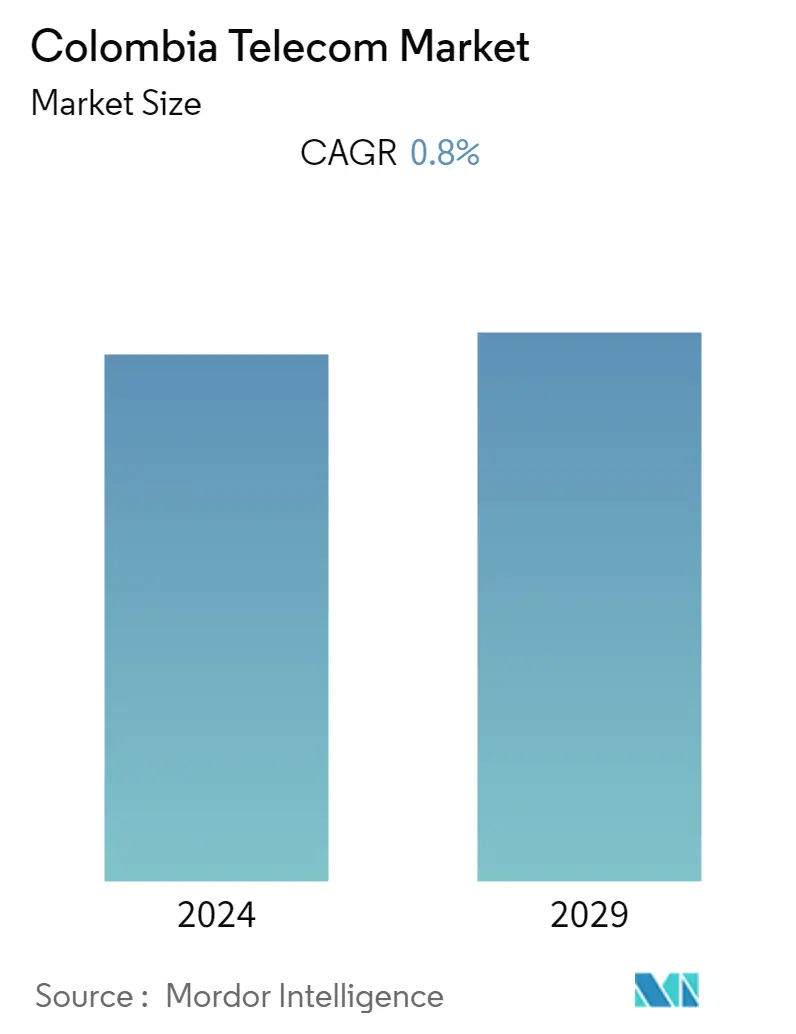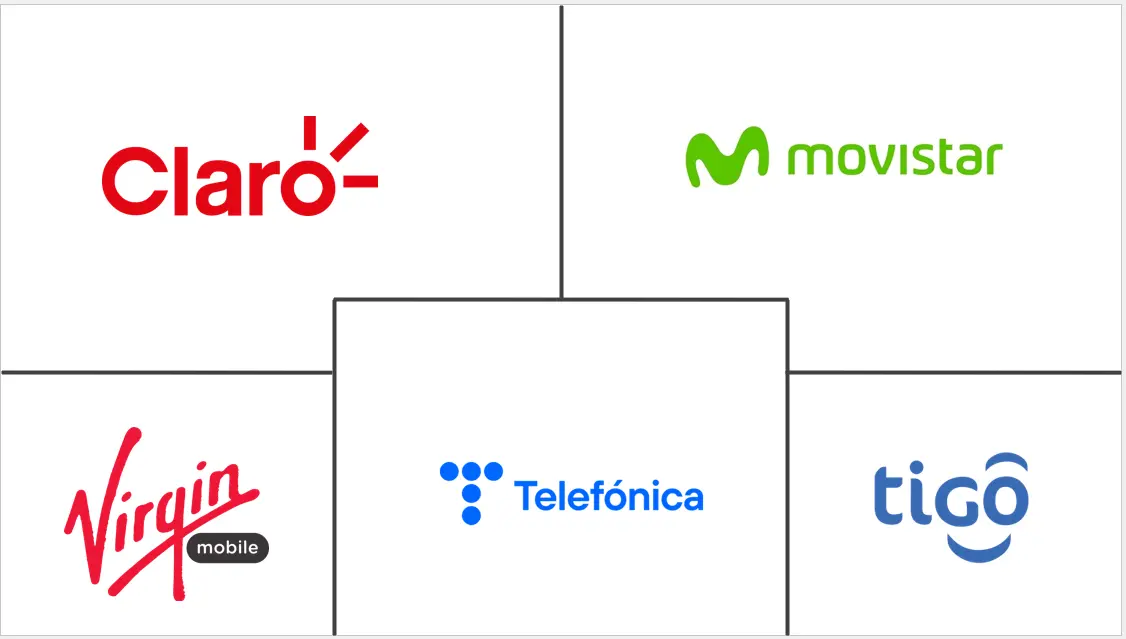Market Size of Colombia Telecom Industry

| Study Period | 2019 - 2029 |
| Base Year For Estimation | 2023 |
| Forecast Data Period | 2024 - 2029 |
| Historical Data Period | 2019 - 2022 |
| CAGR | 0.80 % |
| Market Concentration | Medium |
Major Players
*Disclaimer: Major Players sorted in no particular order |
Colombia Telecom Market Analysis
The Colombian telecom market is expected to grow at a CAGR of 0.8% over the next five years. Key telecom companies, such as Claro Colombia, Movistar Colombia, Virgin Mobile Colombia, Telefonica Colombia, and Tigo Colombia, are based in Colombia and promote innovation by making significant R&D investments consistently.
- The transition to 3G and 4G is still rising in the country due to expanding new networks and increasing demand for high-speed connectivity services. For instance, WOM invested USD 50 million for a 4G rollout that provides connectivity services to 525 unserved rural locations.
- 5G services still need to be fully deployed in Colombia, but key telecom operators have completed 5G demonstrations and trials over the past two years. In the future, all the customers will slowly migrate from 3G and 4G networks to the 5G network. For instance, Empresa de Telecomunicaciones de Bogota (ETB) partnered with ZTE to launch a 5G trial.
- Colombia's telecom industry made further strides in expanding its network capacity with fiber and wireless deployments. For instance, Millicom International Cellular (MIC) deploys an Open Radio Access Network (O-RAN) architecture. The rollout will be carried out in partnership with Parallel Wireless to deliver 4G service coverage at 362 rural sites.
- Fibre broadband penetration will grow over the next five years. For instance, Claro invested USD 25 million to bring fiber optics services to 20 localities and expand coverage in other remote areas. Such investments will further increase the demand for Fibre broadband services.
- During the COVID-19 pandemic, the telecom industry showed sustainable growth in deploying the 4G network. During the coming year, the telecom industry will likely experience an increase in the adoption of the 5G network. It may also be difficult for network operators to manage workflows when maintaining and upgrading existing infrastructure. Overall progress towards the 5G network is expected to impact the market's growth positively.
Colombia Telecom Industry Segmentation
Telecom or telecommunication is the long-range transmission of information by electromagnetic means.
The Colombian telecom market includes an in-depth trend analysis based on connectivity, like fixed networks, mobile networks, and telecom towers. Telecom services are divided into voice services (wired and wireless), data and messaging services, OTT, and PayTV Services. The adoption of telecom services is driven by several factors, including an increasing demand for 5G.
The market sizes and forecasts are provided in terms of value (USD million) for all the above segments.
| By Services | ||||
| ||||
| Data and Messaging Services (Coverage to Include Internet & Handset Data Packages, Package Discounts) | ||||
| OTT and PayTV Services |
Colombia Telecom Market Size Summary
The Colombian telecom market is poised for moderate growth over the next five years, driven by significant investments in network expansion and technological advancements. Key players such as Claro Colombia, Movistar Colombia, Virgin Mobile Colombia, Telefonica Colombia, and Tigo Colombia are at the forefront, investing heavily in research and development to foster innovation. The transition to 3G and 4G networks continues to gain momentum, with substantial investments in rural connectivity and high-speed services. Although 5G deployment is still in its nascent stages, telecom operators have conducted trials and demonstrations, setting the stage for future migration from older networks. The expansion of fiber and wireless deployments, including initiatives like the Open Radio Access Network (O-RAN) architecture, is expected to enhance network capacity and service coverage, particularly in underserved areas.
The market is also witnessing a shift in consumer behavior, with increasing adoption of fiber-to-the-home (FTTH) services and over-the-top (OTT) platforms. The growth of FTTH networks, such as those by Telefonica Colombia and Claro Colombia, is expected to drive fixed broadband penetration, supported by government efforts to expand coverage in rural regions. Meanwhile, the demand for OTT services is rising, fueled by the growing number of mobile subscribers and the popularity of on-demand video content. However, the revenue from PayTV services is anticipated to decline due to competition from OTT providers and a decrease in direct-to-home subscriptions. The market remains moderately fragmented, with ongoing partnerships and strategic agreements among major players, further shaping the competitive landscape.
Colombia Telecom Market Size - Table of Contents
-
1. MARKET INSIGHTS
-
1.1 Market Overview
-
1.2 Industry Ecosystem Analysis
-
1.3 Industry Attractiveness- Porter's Five Force Analysis
-
1.3.1 Bargaining Power of Suppliers
-
1.3.2 Bargaining Power of Consumers
-
1.3.3 Threat of New Entrants
-
1.3.4 Threat of Substitute Products
-
1.3.5 Intensity of Competitive Rivalry
-
-
1.4 Assessment of the Impact of COVID-19 on the Industry Ecosystem
-
1.5 Regulatory Landscape in Colombia
-
-
2. MARKET SEGMENTATION
-
2.1 By Services
-
2.1.1 Voice Services
-
2.1.1.1 Wired
-
2.1.1.2 Wireless
-
-
2.1.2 Data and Messaging Services (Coverage to Include Internet & Handset Data Packages, Package Discounts)
-
2.1.3 OTT and PayTV Services
-
-
Colombia Telecom Market Size FAQs
What is the current Colombia Telecom Market size?
The Colombia Telecom Market is projected to register a CAGR of 0.8% during the forecast period (2024-2029)
Who are the key players in Colombia Telecom Market?
Claro Colombia, Movistar Colombia, Virgin Mobile Colombia, Telefonica Colombia and Tigo Colombia are the major companies operating in the Colombia Telecom Market.

